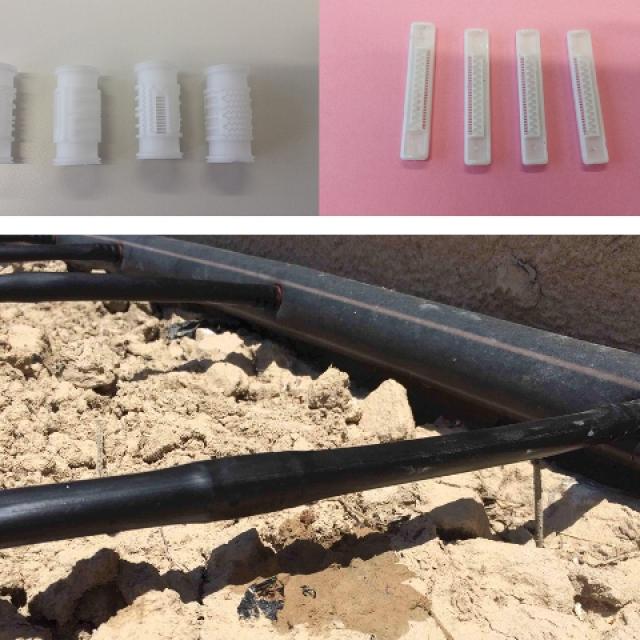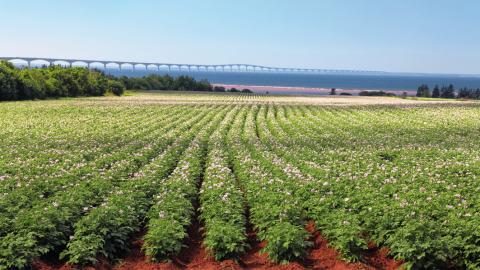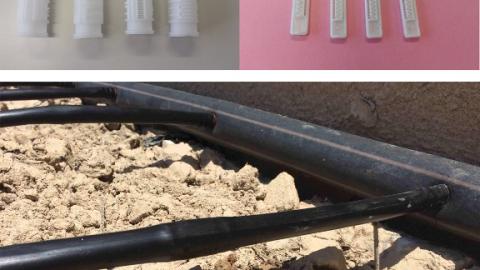The amount of plastic waste generated in agriculture in 2008 by the 27 countries of the European Union plus Norway and Sweden was 1.243 million tons (Mt). 53.6% of the total was thrown away. On the other hand, the remaining 46.4% was recovered: 262.000 tonnes (21%) were mechanically recycled and 315.000 tonnes (25.3%) recovered for use as energy. The amount of waste generated by irrigation pipes and accessories was 200.000 tons1.

The use of compostable or biodegradable products can be an option for increasing the recycling of materials in agriculture. Compostability is the organic transformation of materials/ waste into compost through an aerobic biological process, thus hugely improving the soil. This technique is categorised at the same level as material recycling in the waste management hierarchy of the European Waste Framework Directive2, just below the more favourable option of reuse, but above incineration (even if there is energy recovery).
Why make a micro-irrigation system compostable?
Conventional irrigation systems are produced from polyethylene, derived from fossil resources and not degradable in a natural environment. After their useful life, the systems need to be removed.
The best way of dealing with these installations would be to collect them and recycle them into new irrigation systems or other products. However, in many cases this is not possible due to the fact that the installation is too contaminated or the production site is too far from the farm, leading to high transport costs.
In that case, the systems can be burned in an industrial incineration plant (with emission control) but sometimes these systems are just landfilled or burned in situ by the farmer, leading to a significant negative impact for the environment.
1. Plastic Waste in the Environment, BioIntelligence Service, http://ec.europa.eu/environment/waste/studies /pdf/plastics.pdf
2. Directive 2008/98/EC on waste (Waste Framework Directive)
Therefore, as an alternative, a compostable microirrigation system was developed. This equipment can be collected with the crop residues left in the field after harvest and treated in an industrial composting facility. This cost-effective system of biologically treating organic waste produces valuable compost that can put back into the field, thus improving the soil.
Collaboration between the Spanish companies Extruline Systems and AIMPLAS, the Israeli company Metzerplas and the Belgian company OWS has resulted in the development of a biodegradable or compostable micro-irrigation system.
The project has received funding from the European Community’s Competitiveness and Innovation Framework Programme (CIP/2007/2013), under grant agreement N° ECO/12/332883 (DRIUS3).
3. www.drius.eu
Designing the System and field tests
The geometry of the drippers is an important factor in determining the flow rate required for the different crops. Producing these ingenious systems has been a real challenge for the research team, due to the emitters’ small orifices and specific dimensions. However, it was finally possible to manufacture high quality biodegradable tubular and flat drippers on an industrial scale (Figure 1).
The whole micro-irrigation system (tubes and drippers) was successfully tested under field conditions on a plot located in Murcia, Spain (Figure 2). This is a very hot region with summer temperatures reaching 45-50ºC. The system remained functional during this whole testing period and the results obtained were similar to those of conventional microirrigation systems.
Compostability
What is compostability? The harmonized European norm EN 134324 and international norm ISO 170885 define the requirements that products must fulfil in order to be recognised as compostable, i.e. they must be biodegradable under composting conditions, disintegrate completely during an industrial composting process and have no negative effect on compost quality (negative testing for toxic materials and heavy metals). Biodegradation and disintegration are often the most difficult hurdles for a product to overcome if it is to called compostable.
4. EN 13432Requirements for packaging recoverable through composting and biodegradation - Test scheme and evaluation criteria for the final acceptance of packaging (2000)
5. ISO 17088 Specifications for compostable plastics(2012)
Aerobic biodegradation is the breaking down of the solid carbon found in materials, into CO2, water and biomass. The experiment revealed a complete biodegradation under controlled composting conditions as defined by ISO 148556. According to the EN 13432 and ISO 17088 norms, absolute biodegradation should be 90% or equivalent to 90% of the maximum degradation of a suitable reference substrate such as cellulose. As can be seen from Figure 3, this relative biodegradation criterion was easily reached.
Disintegration is the physical falling apart of a material during the composting process, ensuring that no visual residues of the product remain at the end of the composting cycle.
As the rate of disintegration is strongly influenced by the thickness of the product, the development of an appropriate biodegradable micro-irrigation system was a real challenge. Pipes with a thickness up to 0.97 mm and drippers of the tubular type showed a sufficient level of disintegration during a 12-week composting process, as defined by the norm ISO 169297. The disintegration process is shown in Figure 4. After 2 weeks of composting, clear signs of degradation can be observed. Two weeks later the pipes were strongly covered by fungal growth and they were beginning to break up.
Disintegration continued and after the statutory 12-week period had been completed, full disintegration was achieved in compliance with the relevant norms.
The last requirement for compostability to take place deals with safety issues and compost quality. It must be ensured that the system does not contain harmful substances or heavy metals. Moreover, there was no negative effect on the composting process or the quality of the compost observed when introducing the compound in a 10% concentration at the beginning of the composting process. It was proven that the compost obtained did not negatively affect the emergence and yield of plants (barley and cress) compared to a neutral control compost used at the beginning of the tests.
Conclusion
In the DRIUS EU project a compostable microirrigation system was developed that can be treated with the crop residues, either in an industrial composting facility or in large composting heaps on the farm itself. This provides an environmentally friendly waste treatment option, which is not the case for conventional microirrigation systems. Moreover the possibility exists for using compostability as an option for other agricultural applications such as tomato plant support wires, grape vine trellises, plant stakes and supports…
7. ISO 16929 Plastics – Determination of the Degree of Disintegration of Plastic Materials under Defined Composting Conditions in a Pilot-Scale Test (2013)


